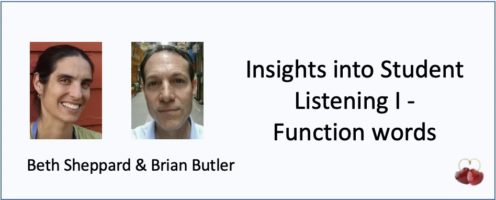47 – Insights into Student Listening …
Beth Sheppard and Brian Butler of the University of Oregon published a paper last year (Sheppard & Butler, 2017 – full reference below) which interests me greatly, as it investigates learners’ ability to decode the stream of speech. This is the first of three posts where I take one of their findings, and then rant and riff about it.
Beth and Brian asked students to write down the last four words that they heard in paused transcription exercises (following Field’s 2008b suggestion). The methodology was carefully designed:
- students at two levels of proficiency (upper-level and mid-level);
- three types of recording including ‘an authentic university lecture available online’;
- 36 four-word phrases were chosen (twelve from each recording).
Learners listened to each of the three recordings, and during each of the twelve pauses, they were asked to write down the last four words that they had heard. (For a more detailed, complete, description of what they did read the paper yourself the reference is given at the foot of this post.)
Briefly some overall statistics:
- 33% of all words were incorrectly transcribed …
- Upper-level students got 27% of all words incorrect
- Mid-level students got 46% of all words incorrect
- 24% of all content words were incorrectly transcribed and …
- 46% of function words were incorrectly transcribed
In this post I am going to focus on the last finding – that 46% of function words were incorrectly transcribed. This percentage is nearly double the number of content words incorrect.
The function-word fallacy
It is a common view in ELT that learners do not need to be able to decode the function words, as they are not as ‘meaning-bearing’ as the content words. Beth and Brian explain the commonly expressed reason for ignoring function words:
… these words are often reduced in speech and also are usually less essential to understanding the overall message of an utterance (p. 89)
I am going to rant and riff about this statement, but before I do I should exclude Beth and Brian from criticism, because they immediately go on to write
…function words can have a significant effect on meaning
And they go on to state that mastery of hearing and understanding function words can free up processing space to work on the content words.
My rant
It is a complete disgrace, in English Language Teaching, that even relatively advanced learners cannot decode the most frequent words in the language – words that they encounter very early in their learning, and which they encounter frequently at every stage of learning.
This inability is a result of two failings in listening pedagogy: a ‘function-word fallacy’ – the false belief that the teacher of listening, and their learners, can ignore these important components of the stream of speech, and leap on the content words to make meaning; and the false belief that continuous practice in coping (the hope-to-cope listening comprehension method) is the only way to teach listening.
These failings are part of an avoidance-of-difficulty strategy which enables teachers to move on to other more tractable, teachable, matters in the classroom, and avoid the difficulty (which in all fairness, they have not been trained to deal with) of teaching students how to decode. (PS John Field also found that advanced learners could not decode function words, cf. Field, 2008a).
My riff
A number of points:
- The sound substance consists of a continuous varying sequence of content and function words. The mushiness of function words will mush-i-fy (‘en-mush’) the soundshapes of the content words because function words and content words are damaged by collisions and the resulting mess exists in a shared rhythmic and perceptual space.
- Therefore I believe it is better not to think of individual function words being the unit of learning/decoding, but rather to prefer word clusters as the unit of learning (cf. Cauldwell, 2018: 96; Carter & McCarthy, 2006: 828ff.) Word clusters are frequently occurring groups of words which consist of blends of function words and very common content words (…I think it’s a..it’s a bit of a…)
- Word clusters comprise a large proportion of the sound substance of the stream of speech
- If learners want to learn the language of normal speech (rather than simply hope to cope), then they need to learn the variety of sound shapes that word clusters can have.
In the following two posts, I look at two particular findings from Beth and Brian’s paper: students’ perceptions of the word study, and their perceptions of the word wouldn’t.
References
Carter, R. & McCarthy, M. (2006). Cambridge Grammar of English: A Comprehensive Guide to Spoken Grammar and Usage. Cambridge: Cambridge University Press.
Cauldwell, R.T. (2018). A Syllabus for Listening – Decoding. Birmingham: Speech in Action.
Field, J. (2008b). Listening in the Language Classroom. Cambridge: Cambridge University Press.
Field, J. (2008a). Bricks or Mortar: Which Parts of the Input Does a Second Language Listener Rely on? TESOL Quarterly, 42/3, 411-432.
Sheppard, B. & Butler, B. (2017). Insights into Student Listening from Paused Transcription. CATESOL Journal, 29.2, 81-107.


